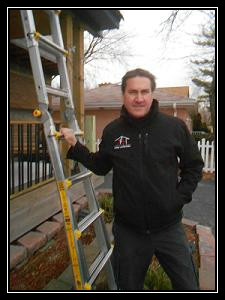Synthetic Stucco (EIFS) Inspections
What is EIFS?
EIFS (exterior insulation finishing system) is one of the most popular types of siding used on homes and commercial buildings today. The product is very attractive and has the appearance of real cement stucco siding, albeit it is a synthetic version that is much more energy efficient.
How is EIFS vulnerable?
EIFS, while being one of the best siding systems ever invented, also has a reputation for serious water damage problems inside of walls due to lack of maintenance and installation errors.
Most EIFS installed on buildings today has a vulnerable surface coating as thin as a soda cracker, applied over the top of foam insulation board that has the structural density of a Styrofoam cup. Because building materials expand and contract with temperature changes, the sealants and surface coatings can crack when EIFS is not installed correctly or maintained annually. I should mention that I have yet to inspect a building with EIFS where the product was installed correctly or maintained annually.
Cracks and installation errors can allow water to enter at roof lines, around windows and doors, at wall vents, utility penetrations, railing attachments, faucets, electric outlets and wall mounted light fixtures.
What are the Consequences?
Once water has entered behind EIFS, it can become trapped and cause significant damage. Issues with EIFS became well known when homeowners began finding wall insulation that was wet and rendered ineffective, rotted structural framing that is supposed to hold their homes up, mold odors, and mold growth on their interior walls and inside of wall cavities. Of course any type of siding can leak when not installed correctly, but EIFS tends to hold moisture behind it for longer periods of time, or indefinitely. It is enduring trapped moisture that causes the damage. While design improvements have been made to EIFS by the manufacturers, it still remains extremely vulnerable when not maintained, or if not installed correctly.
Why is EIFS not maintained?
People who have EIFS installed, or purchase a building that already has this siding, are rarely told about the importance of EIFS siding maintenance. They do not understand that EIFS is supposed to be inspected annually for cracks and then maintained as needed. Because of lack of maintenance, many EIFS clad buildings have water incursion.
Why is EIFS not installed correctly?
Installation contractors can become confused because there are different types of EIFS, each having their own installation standards, and their own exceptions to those standards. The problem is compounded when contractors who offer EIFS, allow it to be installed by employees or subcontractors that are not properly trained, are unmonitored, and most certainly working on tight construction schedules. These problems are a surefire recipe for installation errors and water incursion.
Why is the damage hidden?
Even after water has repeatedly entered behind EIFS siding, the evidence of damage is typically not visible to untrained individuals because it is hidden behind the EIFS. The visible tell-tale signs, installation defects, and even fine cracks, are also not readily apparent to untrained persons.
The cracks in sealants can be as small as 1/5000 of an inch wide and still allow water to pass through. All it takes is one point of water leakage on a building to cause significant damage and the need for major repairs. Without proper inspection, leaks are typically not discovered until after damage has occurred. This is why EIFS manufacturers recommend that the siding be regularly inspected and maintained.
Who performs EIFS inspections?
Building owners are supposed to inspect annually for fine cracks in sealant and surfaces that may open as a result of age. Identifying installation defects and hidden water damage requires professional inspection.
A professional inspection of EIFS siding is always recommended when annual maintenance records are not available, or if there are visible evidences of staining, lack of maintenance, installation errors, or musty odors anywhere indoors.
During real estate transactions, a professional inspection is also recommended. This type of inspection requires specialized equipment and is not part of a general home inspection performed during real estate transactions.
How are EIFS inspections performed?
A professional EIFS inspection includes the use of infrared thermal imaging, a noninvasive technology used to quickly scan EIFS and their adjacent interior walls for suspicious areas.
Suspicious areas are then deep scanned with subsurface radio moisture meters to validate possible moisture behind the siding. Where moisture is confirmed, small holes are drilled through the siding and conductive pin moisture meters are inserted to determine the amounts of moisture trapped behind siding, and the possibility of water damaged insulation, mold contamination, or rotted wall sheathing or framing.
Can EIFS be a good siding choice?
EIFS has the potential to be one of the best siding choices available today, but like all types of siding, it must be installed correctly, inspected annually, and maintained as needed.
An initial inspection performed by a professional can help determine if your EIFS siding is currently in good condition, if hidden problems exist that need to be addressed, and if so, how to proceed.
The time involved for an EIFS inspection can vary depending on the amount of, and condition of, the siding.
During your EIFS inspection you will be given maintenance information to help protect your building from damage.
To schedule an EIFS inspection, click here







